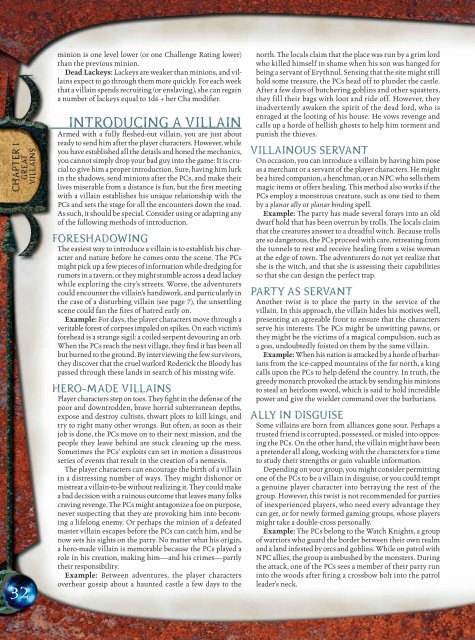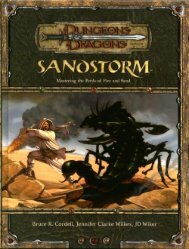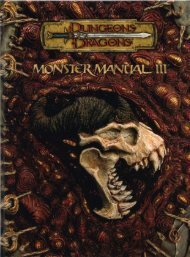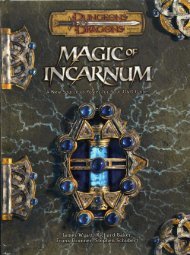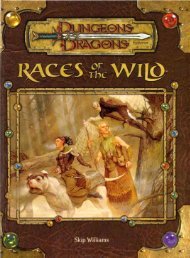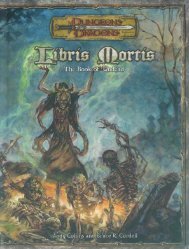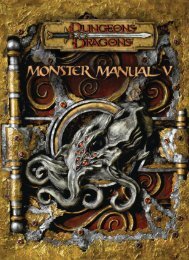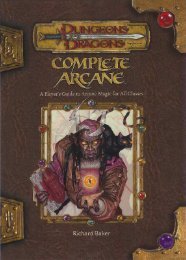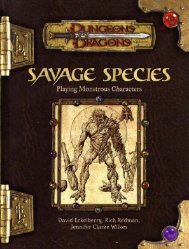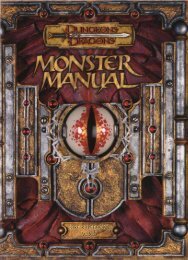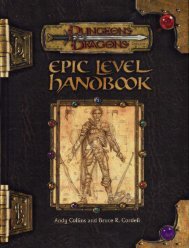Exemplars of Evil
Exemplars of Evil
Exemplars of Evil
Create successful ePaper yourself
Turn your PDF publications into a flip-book with our unique Google optimized e-Paper software.
CHAPTER 1<br />
GREAT<br />
VILLAINS<br />
32<br />
minion is one level lower (or one Challenge Rating lower)<br />
than the previous minion.<br />
Dead Lackeys: Lackeys are weaker than minions, and villains<br />
expect to go through them more quickly. For each week<br />
that a villain spends recruiting (or enslaving), she can regain<br />
a number <strong>of</strong> lackeys equal to 1d6 + her Cha modifier.<br />
INTRODUCING A VILLAIN<br />
Armed with a fully fleshed-out villain, you are just about<br />
ready to send him after the player characters. However, while<br />
you have established all the details and honed the mechanics,<br />
you cannot simply drop your bad guy into the game: It is crucial<br />
to give him a proper introduction. Sure, having him lurk<br />
in the shadows, send minions after the PCs, and make their<br />
lives miserable from a distance is fun, but the first meeting<br />
with a villain establishes his unique relationship with the<br />
PCs and sets the stage for all the encounters down the road.<br />
As such, it should be special. Consider using or adapting any<br />
<strong>of</strong> the following methods <strong>of</strong> introduction.<br />
FORESHADOWING<br />
The easiest way to introduce a villain is to establish his character<br />
and nature before he comes onto the scene. The PCs<br />
might pick up a few pieces <strong>of</strong> information while dredging for<br />
rumors in a tavern, or they might stumble across a dead lackey<br />
while exploring the city’s streets. Worse, the adventurers<br />
could encounter the villain’s handiwork, and particularly in<br />
the case <strong>of</strong> a disturbing villain (see page 7), the unsettling<br />
scene could fan the fires <strong>of</strong> hatred early on.<br />
Example: For days, the player characters move through a<br />
veritable forest <strong>of</strong> corpses impaled on spikes. On each victim’s<br />
forehead is a strange sigil: a coiled serpent devouring an orb.<br />
When the PCs reach the next village, they find it has been all<br />
but burned to the ground. By interviewing the few survivors,<br />
they discover that the cruel warlord Roderick the Bloody has<br />
passed through these lands in search <strong>of</strong> his missing wife.<br />
HERO-MADE VILLAINS<br />
Player characters step on toes. They fight in the defense <strong>of</strong> the<br />
poor and downtrodden, brave horrid subterranean depths,<br />
expose and destroy cultists, thwart plots to kill kings, and<br />
try to right many other wrongs. But <strong>of</strong>ten, as soon as their<br />
job is done, the PCs move on to their next mission, and the<br />
people they leave behind are stuck cleaning up the mess.<br />
Sometimes the PCs’ exploits can set in motion a disastrous<br />
series <strong>of</strong> events that result in the creation <strong>of</strong> a nemesis.<br />
The player characters can encourage the birth <strong>of</strong> a villain<br />
in a distressing number <strong>of</strong> ways. They might dishonor or<br />
mistreat a villain-to-be without realizing it. They could make<br />
a bad decision with a ruinous outcome that leaves many folks<br />
craving revenge. The PCs might antagonize a foe on purpose,<br />
never suspecting that they are provoking him into becoming<br />
a lifelong enemy. Or perhaps the minion <strong>of</strong> a defeated<br />
master villain escapes before the PCs can catch him, and he<br />
now sets his sights on the party. No matter what his origin,<br />
a hero-made villain is memorable because the PCs played a<br />
role in his creation, making him—and his crimes—partly<br />
their responsibility.<br />
Example: Between adventures, the player characters<br />
overhear gossip about a haunted castle a few days to the<br />
north. The locals claim that the place was run by a grim lord<br />
who killed himself in shame when his son was hanged for<br />
being a servant <strong>of</strong> Erythnul. Sensing that the site might still<br />
hold some treasure, the PCs head <strong>of</strong>f to plunder the castle.<br />
After a few days <strong>of</strong> butchering goblins and other squatters,<br />
they fill their bags with loot and ride <strong>of</strong>f. However, they<br />
inadvertently awaken the spirit <strong>of</strong> the dead lord, who is<br />
enraged at the looting <strong>of</strong> his house. He vows revenge and<br />
calls up a horde <strong>of</strong> hellish ghosts to help him torment and<br />
punish the thieves.<br />
VILLAINOUS SERVANT<br />
On occasion, you can introduce a villain by having him pose<br />
as a merchant or a servant <strong>of</strong> the player characters. He might<br />
be a hired companion, a henchman, or an NPC who sells them<br />
magic items or <strong>of</strong>fers healing. This method also works if the<br />
PCs employ a monstrous creature, such as one tied to them<br />
by a planar ally or planar binding spell.<br />
Example: The party has made several forays into an old<br />
dwarf hold that has been overrun by trolls. The locals claim<br />
that the creatures answer to a dreadful witch. Because trolls<br />
are so dangerous, the PCs proceed with care, retreating from<br />
the tunnels to rest and receive healing from a wise woman<br />
at the edge <strong>of</strong> town. The adventurers do not yet realize that<br />
she is the witch, and that she is assessing their capabilities<br />
so that she can design the perfect trap.<br />
PARTY AS SERVANT<br />
Another twist is to place the party in the service <strong>of</strong> the<br />
villain. In this approach, the villain hides his motives well,<br />
presenting an agreeable front to ensure that the characters<br />
serve his interests. The PCs might be unwitting pawns, or<br />
they might be the victims <strong>of</strong> a magical compulsion, such as<br />
a geas, undoubtedly foisted on them by the same villain.<br />
Example: When his nation is attacked by a horde <strong>of</strong> barbarians<br />
from the ice-capped mountains <strong>of</strong> the far north, a king<br />
calls upon the PCs to help defend the country. In truth, the<br />
greedy monarch provoked the attack by sending his minions<br />
to steal an heirloom sword, which is said to hold incredible<br />
power and give the wielder command over the barbarians.<br />
ALLY IN DISGUISE<br />
Some villains are born from alliances gone sour. Perhaps a<br />
trusted friend is corrupted, possessed, or misled into opposing<br />
the PCs. On the other hand, the villain might have been<br />
a pretender all along, working with the characters for a time<br />
to study their strengths or gain valuable information.<br />
Depending on your group, you might consider permitting<br />
one <strong>of</strong> the PCs to be a villain in disguise, or you could tempt<br />
a genuine player character into betraying the rest <strong>of</strong> the<br />
group. However, this twist is not recommended for parties<br />
<strong>of</strong> inexperienced players, who need every advantage they<br />
can get, or for newly formed gaming groups, whose players<br />
might take a double-cross personally.<br />
Example: The PCs belong to the Watch Knights, a group<br />
<strong>of</strong> warriors who guard the border between their own realm<br />
and a land infested by orcs and goblins. While on patrol with<br />
NPC allies, the group is ambushed by the monsters. During<br />
the attack, one <strong>of</strong> the PCs sees a member <strong>of</strong> their party run<br />
into the woods after firing a crossbow bolt into the patrol<br />
leader’s neck.


